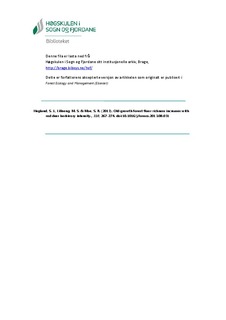| dc.description.abstract | Herbivory is one of the most important biotic disturbance types globally and is important for community structure and composition through species filtering. In northern forest ecosystems the population densities of wild-ranging ungulates, which are managed through hunting, have reached historically high numbers. Conservation concerns frequently arise, both in media and scientific literature. One key question is whether increased deer densities negatively affect biodiversity and whether management should implement reduction in deer densities. Few studies have addressed wild herbivores-plant richness relationships using a full length gradient of herbivory. Such gradient approach where herbivory is studied from very low to very high intensity, may enable us to develop operational management guidelines for deer densities We recorded the ungulate herbivory intensities on the island Svanøy in west Norway across 10 years and related this to the present plant richness of an old-growth pine-forest system, recording all plant species groups of the forest understory. The herbivory intensity-plant richness relationship followed a unimodally peaked curved, but plant richness was lower only at forest sites with artificially high red deer herbivory. Overall, the herbivory-richness relationships of functional groups fitted expectations in that the richness of low-growing functional groups as forbs, graminoids and mosses all increased within natural levels of herbivory intensities, whereas the richness of the taller growing woody species of the forest understory, dwarf-shrubs and young trees, decreased along the intensity gradient. We validated the gradient approach by experimental exclosure data. Management for relatively high deer densities may benefit the overall understory plant richness of such forest ecosystems at the expense of richness of woody plants. We suggest that the herbivory-induced reduction of the understory woody layer is the key to understand the overall increase in plant species richness. | |
